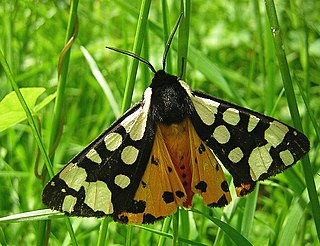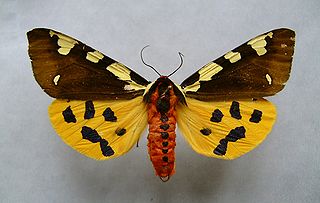
The Arctiina are a subtribe of moths in the family Erebidae.

Arctia is a genus of tiger moths in the family Erebidae. Therein, it belongs to the subtribe Arctiina in the tribe Arctiini in the subfamily Arctiinae. Species are well distributed throughout North America, Palearctic, India, and Sri Lanka.

Arctia villica, the cream-spot tiger, is a moth of the family Erebidae. The species was first described by Carl Linnaeus in his 1758 10th edition of Systema Naturae. It is distributed from the Iberian Peninsula, Anatolia, western and northern Iran, western Siberia, southwestern Asia and North Africa.
Micrarctia is a tiger moth genus in the family Erebidae described by Seitz in 1910. The genus currently contains two species. Both species are found in central to western China, including the Chinese provinces of Qinghai and Sichuan.

Arctia is species of tiger moth in the family Erebidae. It was first described by Carl Linnaeus in his 1758 10th edition of Systema Naturae. It can be found in central and eastern Europe, Kazakhstan, southern Siberia, northern Mongolia, Amur Region, Primorye, Sakhalin, Kunashir, northern and northeastern China, Korea and Japan.

Arctia tigrina is a moth of the family Erebidae. It is found on the Iberian Peninsula and the South of France and Italy.

Arctia aulica, the brown tiger moth, is a moth of the family Erebidae. The species was first described by Carl Linnaeus in his 1758 10th edition of Systema Naturae. It is found in the temperate areas of central Europe up to the area surrounding the Amur River to the east and up to the Balkans and the Black Sea to the south.

Arctia dejeani is a species of moth in the family Erebidae first described by Jean Baptiste Godart in 1822. It is found on the Iberian Peninsula.
Arctia dido is a moth of the family Erebidae. It was described by M. Wagner in 1841. It is found in Algeria.
Arctia ungemachi is a moth of the family Erebidae. It was described by Ferdinand Le Cerf in 1924. It is found in Morocco.

Arctia testudinaria, or Patton's tiger, is a moth of the family Erebidae. It was described by Geoffroy in 1785. It is found from northern Spain to southern and central France and southern Switzerland to north-eastern and southern Italy. It has also been recorded from Great Britain. The habitat consists of grasslands, slopes, forest edges, clear dry forests, cliffs and mountain slopes, maquis, garrigues and dry meadows.
Arctia gurkoi is a moth of the family Erebidae. It was described by Vladimir Viktorovitch Dubatolov in 2004. It is found in Pakistan and possibly Xinjiang, China.
Arctia allardi is a moth in the family Erebidae. It was described by Charles Oberthür in 1911. It is found in China.
Arctia cupido is a moth in the family Erebidae. It was described by Yasunori Kishida in 1995. It is found in Nepal.
Arctia hannyngtoni is a moth in the family Erebidae. It was described by George Hampson in 1910. It is found in the north-western Himalayas and Nepal.
Arctia romanovi is a moth in the family Erebidae. It was described by Grigory Grum-Grshimailo in 1891. It is found in the north-western Chinese province of Qinghai.

Diacrisia metelkana is a moth in the family Erebidae. It was described by Julius Lederer in 1861. It is found in southern and central Europe, Russia, eastern Asia and Japan.
Diacrisia nebulosa is a moth in the family Erebidae. It was described by Arthur Gardiner Butler in 1877. It is found in the Russian Far East, China, Japan and possibly Korea.
Arctia forsteri is a moth in the family Erebidae. It was described by Franz Daniel in 1943. It is found in Sichuan, China.
Arctia sieversi is a moth in the family Erebidae. It was described by Grigory Grum-Grshimailo in 1891. It is found in Qinghai, China.








